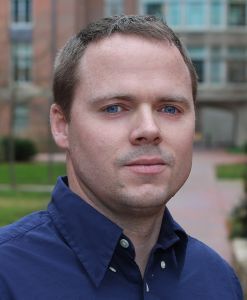UNC Chemists Find Gentler Way to Reshape Fluorine Bonds, Opening Door to Better Medicines

Left to right, Associate Professor Simon Week and Ph.D. students José Rosario-Collazo and Courtney Westlund have found two new ways to reshape fluorinated molecules using mild, selective chemistry that avoids harsh conditions. They describe their methods in studies recently published in Organic Letters and Angewandte Chemie International Edition (ACIE).
October 29, 2025 I By Dave DeFusco
Fluorine may not be a household word, but this small, highly reactive element plays a big role in modern medicine. It can change the way a drug behaves in the body, helping it last longer, work better or reach the right cells. Nearly one in five new medicines contains at least one fluorine atom. But adding fluorine to molecules or even moving it to a different spot is difficult. The bond between carbon and fluorine is one of the strongest in organic molecules. Breaking it and rebuilding it in a controlled way has challenged chemists for decades.
Now, a team of researchers at UNC-Chapel Hill has found two new ways to reshape fluorinated molecules using mild, selective chemistry that avoids harsh conditions. The discoveries, both led by José Rosario-Collazo, a Ph.D. student in the Department of Chemistry, and Simon Meek, senior author of the study and an associate professor, were recently published in Organic Letters and Angewandte Chemie International Edition (ACIE).
Together, they represent a major step forward in the chemistry of fluorine, offering practical new methods for designing molecules that could lead to better medicines and materials.

In the first study, published in Organic Letters, Rosario-Collazo and Professor Meek developed a method utilizing defluoro carbon–carbon coupling, which allows chemists to gently break carbon–fluorine bonds in a controlled way.
Traditionally, chemists have relied on high heat, expensive metals or strong acids to modify fluorinated compounds, methods that can destroy delicate molecular structures. The Carolina team instead used a Lewis base activator and organodiboron reagents to initiate a gentler reaction that targets one fluorine atom in a common chemical group known as trifluoromethyl.
By removing one of the three fluorine atoms and replacing it with a carbon-based group, they accessed compounds called benzylic difluoromethyl and monofluoromethyl arenes, which are useful building blocks in drug design.
“Fluorine atoms are key elements in molecular design,” said Rosario-Collazo. “They can make a molecule more stable or change the way it interacts with proteins in the body, but controlling the functionalization of carbon-fluorine bonds has always been hard. Our goal was to make that process simpler and more predictable.”
The reaction is efficient, works with many different kinds of starting materials and produces desired products selectively. “This work provides chemists a new strategy to transform one of the most robust bonds in organic chemistry,” said Professor Meek. “It opens up possibilities for designing molecules with new properties, whether for pharmaceuticals, crop protection or advanced materials.”
While perfecting that reaction, Rosario-Collazo noticed a surprising chemical pattern that led to another significant discovery. That insight became the foundation of his second study, published in Angewandte Chemie International Edition.
In the study, Rosario-Collazo, Courtney Westlund, a UNC Ph.D. student, and Professor Meek describe a stereoselective method, which makes one geometrical version of a molecule on purpose, for building alkenyl fluorides and alkynes—molecules that have become increasingly important in drug and materials development. These compounds are known for their chemical stability and specific structure, which make them especially valuable for designing pharmaceuticals that resist breakdown in the body.
Their new method turns simple, easy-to-find trifluoromethyl arenes—ring-shaped molecules that contain fluorine—into fluorinated alkenes with very high efficiency and precision. In other words, it produces large amounts of one clean, precisely shaped product. Even more remarkable, the reaction works without using transition metals. Instead, it relies on a boron-based reagent and a mild fluoride activator to build new carbon–carbon bonds, making it both cost-effective and environmentally friendly.
“This chemistry lets us turn an unreactive part of a molecule into something incredibly useful,” said Rosario-Collazo. “Fluoroalkenes are hard to make, but they’re very useful because they can act like the bonds found in many medicines and help those drugs last longer in the body.”
The team also found that by slightly changing the reaction conditions, they could push the transformation further, creating alkyne products which are another versatile class of molecules used to make pharmaceuticals, polymers and electronic materials.
Both discoveries share a common theme: turning something thought of as chemically unchangeable into a versatile starting point for innovation. The methods allow chemists to begin with abundant, inexpensive materials and gently transform them into complex, precisely shaped molecules that would otherwise be difficult to make.
“Every time we learn how to move or replace a fluorine atom more easily, we open up new possibilities for better medicines and materials,” said Rosario-Collazo.

